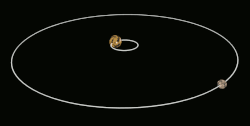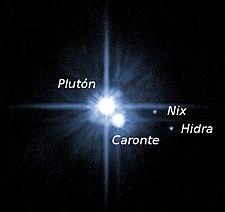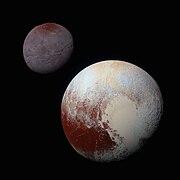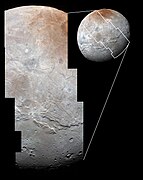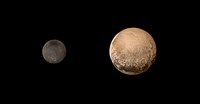Charon (satellite)
Charon is Pluto's largest satellite, discovered by American astronomer James W. Christy in 1978. Its name is reminiscent of Charon, a boatman on the Acheron river in Greek mythology who was in charge of take souls to hell Its shape is spherical and it is formed mainly by ice. It has the particularity of always showing the same face to Pluto and always seeing the same face of it while both rotate around their center of mass.
For many years it was thought that Charon was the only satellite orbiting Pluto, but at the end of 2005 the existence of two other small bodies was announced and provisionally named S/ 2005 P 1 and S/2005 P 2. In February 2006 the Hubble Space Telescope confirmed the presence of these two bodies and in June of that same year the International Astronomical Union named them, renaming them Hydra and Nix respectively. On July 20, 2011 NASA announced the discovery of a fourth moon orbiting the dwarf planet, again by Hubble, it is P4 (provisional name), the smallest of the 4 moons. discovered up to that time with a diameter of between 13 and 34 km. On July 12, 2012, NASA made a new announcement of the discovery of an even smaller satellite, between 10 and 24 km, provisionally named P5 and detected again thanks to Hubble observations. In July 2013, these two small satellites were named Cerberus and Styx respectively.
NASA's New Horizons probe was launched into space in 2006 with the primary purpose of visiting Pluto and Charon. Its arrival was on July 13, 2015. In July 2013, it sent the first images in which Charon can be seen as a separate body from Pluto.
Discovery
Charon was discovered on June 22, 1978 by United States Naval Observatory astronomer James W. Christy, who noticed something very peculiar in images of Pluto obtained with the Flagstaff Observatory telescope. The images obtained presented Pluto with a slightly elongated shape, while the stars that appeared in the same photograph did not present this distortion.
A check in the observatory archive revealed that some of the other images taken under excellent visibility conditions also showed this elongation, although most did not. This effect could be explained if there was another object periodically orbiting Pluto that was not large enough to be seen by the telescope.
Christy continued her research and discovered that all the observations could be explained if the object in question had an orbital period of 6.387 days and a maximum separation from the planet of one arcsecond. Pluto's rotation period is just 6.387 days, and since it was almost certain that the satellite had the same rotation period, he deduced that this was the only known planet-satellite system in which both showed the same face continuously. The few remaining doubts of its existence were dispelled when the system entered a five-year period of eclipses between 1985 and 1990. This phenomenon occurs when the orbital plane of Pluto and Charon is located edge-on with respect to the view from Earth.. This happens only twice during Pluto's 248-year orbital period. It was great luck that one of those eclipse intervals occurred shortly after the discovery of Charon.
The first images of Pluto and Charon resolved as separate disks were taken by the Hubble Space Telescope in the 1990s. Later, the development of adaptive optics made it possible to also resolve separate disks using ground-based telescopes.
With the discovery of Charon, the theory that Pluto was an escaped satellite of Neptune was ruled out.
Origin of name
Charon was originally called by the name S/1978 P 1, according to recently established convention. Christy immediately chose the name "Charon" (Charon in English), but its official adoption by the International Astronomical Union had to wait until well into 1985 and was announced on January 3, 1986.
The name Charon comes from Greek mythology; he was in charge of leading the souls of the recently dead through the Styx lagoon to take them to the kingdom of Hades, which in Roman mythology corresponds to Pluto.
Physical characteristics
The diameter of Charon is 1,208 km, just over half that of Pluto, with an area of 4,580,000 km². Unlike Pluto, which is covered in nitrogen and methane ice, Charon's surface appears to be dominated by water ice. It also seems to have no atmosphere. In 2007, observations by the Gemini Observatory of ammonia hydrates and water crystals on the surface of Charon suggested the presence of "cryogeysers" assets.
The mutual eclipses of Pluto and Charon in the 1980s allowed astronomers to analyze the spectral lines of Pluto and that of both stars combined. By subtracting Pluto's spectrum from the total, they were able to determine the composition of Charon's surface.
The volume and mass of Charon allow us to calculate its density; Knowing this, we can say that it is an icy body and contains proportionately fewer rocks than its companion, supporting the idea that Charon was created by a gigantic impact on Pluto's icy mantle (see "Formation" later). There are two conflicting theories about the internal structure of Charon: some scientists believe that it is a distinct body like Pluto, with a rock core and a mantle of ice, while others believe that Charon has a uniform composition. Evidence has been found to support the first hypothesis. The finding of ammonia hydrates and water crystals on the surface of Charon suggests the presence of "cryogeysers" assets. The fact that the ice was still in crystalline form suggests that it was recently deposited, as solar radiation would have degraded the ancient ice to an amorphous state after about 30,000 years.
Orbital characteristics and classification
Charon is an average of 19,570 km from Pluto, making it 20 times closer to it than the Moon is to Earth. The two objects are gravitationally locked, and therefore always show the same face to each other. Charon's discovery allowed astronomers to accurately calculate the mass of the Plutonian system, and mutual occultations revealed their sizes. However, they did not establish their individual masses, which could only be estimated after the discovery of Pluto's other satellites, well into 2005. Details revealed by the outer satellites show that Charon is about 11.65% as massive as Pluto. from Pluto.
Training
Pluto and Charon are thought to have been two bodies that collided before entering each other's orbit. The collision would have been violent enough to boil volatile ices like methane, but not violent enough to be disrupted.
In a simulation paper published in 2005, Robin Canup suggests that Charon may have formed by a gigantic impact around 4.5 billion years ago, similar to Earth and the Moon. In this model a large Kuiper belt object hits Pluto at high speed, destroying itself and scattering much of the planet's outer mantle. Then Charon is formed by the fusion of the remains. However, such an impact would result in a rockier Pluto and more icy Charon than scientists have found.
Satellite or dwarf planet?
The fact that Charon does not actually revolve around Pluto as a satellite, but instead both Pluto and Charon revolve around the center of mass of the system, has led many not to consider Pluto and Charon as a planet and satellite respectively, but rather as a double dwarf planet.
On August 16, 2006, before the International Astronomical Union (IAU), a draft resolution was presented that, if approved, would have established the definition of a planet as "a body that is massive enough to be spherical, which is not a star, but orbits around one." Under this definition, bodies such as Ceres (formerly an asteroid belt asteroid), Charon, Eris, and various Kuiper belt objects that probably met the definition would have been added to the list of planets. Finally, on August 24, said resolution was not approved and a definition of a double planet was not created either. In the final definition of a planet, Pluto was reclassified as a dwarf planet, but the formal definition of a planetary satellite was not determined, leaving Charon in an uncertain state (Charon is not on the list of dwarf planets recognized by the IAU).
The satellites Nix and Hydra also orbit the same barycenter, but they are not large enough to be spherical and are therefore considered satellites of Pluto (or, from another point of view, of the Pluto-Charon system).
Observation
Due to its small size and excessive proximity to the planet, it is invisible to all but the largest ground-based telescopes under the best weather conditions (see seeing).
Gallery
|
Video
(Published on 1 October 2015).
Contenido relacionado
Transneptunian object
Polaris (star)
National Center for Space Studies

